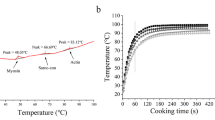Abstract
A methodology for assessing fish freshness based on the capillary zone electrophoresis analysis of methanol-soluble compounds extracted from white muscle is presented. Two fatty fish species, mackerel (Scomber scombrus) and horse mackerel (Trachurus trachurus), and two lean species, hake (Merluccius merluccius) and blue whiting (Micromesistius poutassou), were studied. Peaks were characterized by their retention times and intensities relative to imidazole, and the four species showed similar electrophoretic profiles. The intensity of peaks with short retention times decreased during chilling storage, and that of peaks with longer retention times increased during storage. The variability and calibration of the instrumental method were established by correlation analysis with the time of chilling and sensory measurements.
Similar content being viewed by others
Author information
Authors and Affiliations
Additional information
Received: 22 April 1999 / Revised version: 9 July 1999
Rights and permissions
About this article
Cite this article
Medina, I., Aubourg, S. & Gallardo, J. Evolution of capillary zone electrophoresis profiles of methanol soluble compounds during fish chilling: relation to freshness. Eur Food Res Technol 210, 353–358 (2000). https://doi.org/10.1007/s002170050563
Issue Date:
DOI: https://doi.org/10.1007/s002170050563




